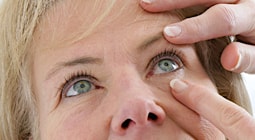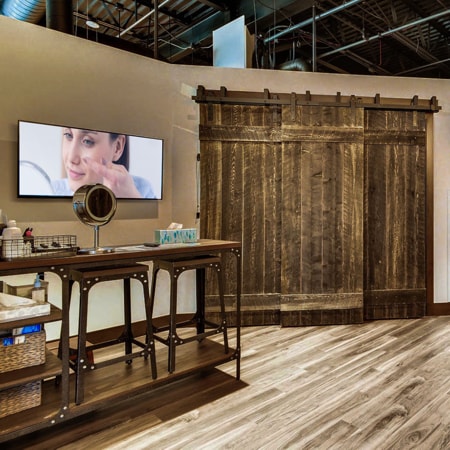Age-Related Macular Degeneration
Age-related macular degeneration is a progressive eye disease that affects your central vision. It is the leading cause of severe vision loss in Americans over the age of 55 years old.
AMD occurs when the macula—the small central portion of the retina—begins to deteriorate. The macula is responsible for central vision, allowing you to see fine details like while reading books or recognizing the faces of your loved ones.
There are 2 types of AMD, and you can potentially have both. Roughly 90% of AMD cases are dry (atrophic), while the remaining 10% are wet (exudative).
- Dry (Atrophic) AMD occurs when the layer of cells beneath the retina begins to age and thin out. The most common sign of dry AMD is yellow deposits (called drusen) in the macula. Over time, the drusen grow in size and quantity, affecting your vision by distorting and dimming it. If left untreated, advanced stage dry AMD will result in the complete loss of central vision.
- Wet (Exudative) AMD is the more severe form of AMD. Irregular and weakened blood vessels form underneath the retina, breaking into the macula and causing blood and other fluids to leak. This results in distorted vision and blind spots.
Glaucoma
Glaucoma is a group of eye disorders that progressively damage your eye’s optic nerve. It is the leading cause of blindness in Americans over the age of 60 years old.
Your optic nerve, made up of many nerve fibers, is connected to your eye’s retina (the layer of light-sensitive tissue lining the inside of your eye). Signals are sent from your retina to your brain via your optic nerve. When you have a buildup of fluid pressure in your eye, the optic nerve may become damaged.
Without a healthy optic nerve, your brain is unable to receive images from your eyes.
Common types of glaucoma include:
- Open-angle Glaucoma: This is the most common form of glaucoma and occurs when the meshwork of the eye is unable to efficiently drain fluid.
- Angle-closure Glaucoma: This is a less common form of glaucoma. It is the result of the drainage angle closing or becoming blocked.
- Secondary Glaucoma: This is a result of an injury or eye disease. A variety of medical conditions, medications, and eye abnormalities can lead to secondary glaucoma.
- Normal-tension or Low-tension Glaucoma: This occurs even when the eye pressure remains normal. Research has yet to determine why optic nerve damage occurs.
Diabetic Retinopathy
Diabetic retinopathy is the most common disease that affects those with diabetes. The blood vessels of your retina—the light-sensitive tissue that lines the back of your eye—are directly affected by diabetic retinopathy. These damaged blood vessels are weak and tend to leak blood and other fluids into your eye. This leakage causes the retinal tissue to swell, leading to distorted or noticeably dim vision.
If diabetic retinopathy is left untreated, complete vision loss can be expected.
Symptoms include:
- Spots or floaters
- Blurred vision
- Difficulty seeing at night
- A dark or empty spot in the center of your vision
Cataracts
A cataract presents as a cloudy area in the usually clear crystalline lens of your eye. They can develop in one or both eyes and are a common cause of vision loss in Americans over the age of 40.
Unfortunately, a byproduct of our natural aging process is the eventual clouding of the eye’s lens. The lens in our eye progressively increases in thickness and decreases in flexibility and transparency, resulting in cataracts.
Conjunctivitis
When your conjunctiva—the thin, clear tissue covering the white part of your eye—becomes inflamed, you have a condition commonly referred to as pink eye (conjunctivitis).
Conjunctivitis is a common eye infection that anyone can contract, especially children. It can affect one or both eyes and, depending on the type you have, it can be highly contagious.
There are 3 common types of pink eye:
- Bacterial Conjunctivitis: Conjunctivitis caused by bacteria is treated with an antibiotic regimen. This may include eye drops, medicated ointments, or oral medication. Bacterial conjunctivitis is contagious and can be transferred through direct contact with infected hands or objects that have touched the eye.
- Viral Conjunctivitis: Since the root cause of viral conjunctivitis is a virus, antibiotics have no effect. Much like the common cold, this form of conjunctivitis must run its course. Because viral conjunctivitis is contagious, it is recommended that you avoid public places and contact with others in addition to strict personal hygiene.
- Allergic Conjunctivitis: Red eye is a common symptom faced by allergy sufferers. It can be treated by over-the-counter allergy medications such as eye drops or oral medication.
















